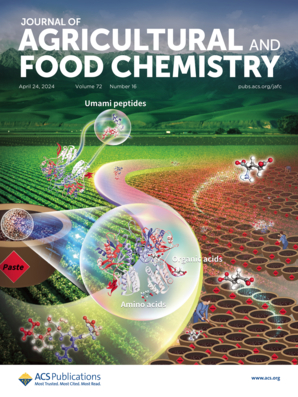Identification and Taste Characteristics of Six Novel Umami Peptides from Mytilus coruscus and Their Interaction with the T1R1/T1R3 Receptor.
IF 6.2
1区 农林科学
Q1 AGRICULTURE, MULTIDISCIPLINARY
引用次数: 0
Abstract
Mytilus coruscus is a commercially significant shellfish, highly regarded for its umami taste. In this study, umami taste peptides in M. coruscus were isolated and characterized through virtual screening, molecular docking, molecular dynamics simulations, sensory evaluation, and electronic tongue assessment. In silico enzymatic hydrolysis of M. coruscus myosin was performed, enabling the selection of six potential umami peptides (CR, ACR, GAR, PDL, PDPN, and SDADCF) based on predictions of umami taste, biological activity, toxicity, and water solubility. The interaction mechanisms between these peptides and the umami receptor T1R1/T1R3 were analyzed through molecular docking and dynamics simulations, revealing that SDADCF exhibited the most stable binding with T1R1/T1R3. The key residues of Asp, His, Glu, and Ser in T1R1 and T1R3 were identified as crucial active sites for umami peptide binding. Hydrogen bonding and electrostatic interactions were found to be the primary forces driving this binding. Furthermore, the umami taste of these peptides was validated using sensory evaluation, indicating that SDADCF had the most intense umami taste (umami score of 5.8) and a threshold of 0.25-0.99 mmol/L for the six peptides. Electronic tongue analysis further recognized the umami taste of the peptides. The identification of these six umami peptides contributes to a deep molecular basis of the strong umami taste within M. coruscus.贻贝6种新型鲜味肽的鉴定、风味特征及其与T1R1/T1R3受体的相互作用
贻贝(Mytilus coruscus)是一种具有重要商业价值的贝类,因其鲜味而备受推崇。本研究通过虚拟筛选、分子对接、分子动力学模拟、感官评价和电子舌评价等方法,分离并表征了红桃鲜味肽。在硅酶水解M. coruscus肌球蛋白,使选择六种潜在的鲜味肽(CR, ACR, GAR, PDL, PDPN和SDADCF)基于鲜味的味道,生物活性,毒性和水溶性的预测。通过分子对接和动力学模拟分析了这些多肽与鲜味受体T1R1/T1R3的相互作用机制,发现SDADCF与T1R1/T1R3的结合最为稳定。在T1R1和T1R3中,Asp、His、Glu和Ser的关键残基被确定为鲜肉肽结合的关键活性位点。发现氢键和静电相互作用是驱动这种结合的主要力量。此外,通过感官评价验证了这些肽的鲜味,结果表明SDADCF具有最强烈的鲜味(鲜味评分为5.8),6种肽的阈值为0.25 ~ 0.99 mmol/L。电子舌分析进一步确认了肽的鲜味。这六种鲜味肽的鉴定有助于为密菇强烈的鲜味提供深入的分子基础。
本文章由计算机程序翻译,如有差异,请以英文原文为准。
求助全文
约1分钟内获得全文
求助全文
来源期刊
CiteScore
9.90
自引率
8.20%
发文量
1375
审稿时长
2.3 months
期刊介绍:
The Journal of Agricultural and Food Chemistry publishes high-quality, cutting edge original research representing complete studies and research advances dealing with the chemistry and biochemistry of agriculture and food. The Journal also encourages papers with chemistry and/or biochemistry as a major component combined with biological/sensory/nutritional/toxicological evaluation related to agriculture and/or food.

 求助内容:
求助内容: 应助结果提醒方式:
应助结果提醒方式:


